roof rack HYUNDAI TUCSON 2013 Owners Manual
[x] Cancel search | Manufacturer: HYUNDAI, Model Year: 2013, Model line: TUCSON, Model: HYUNDAI TUCSON 2013Pages: 397, PDF Size: 5.55 MB
Page 111 of 397
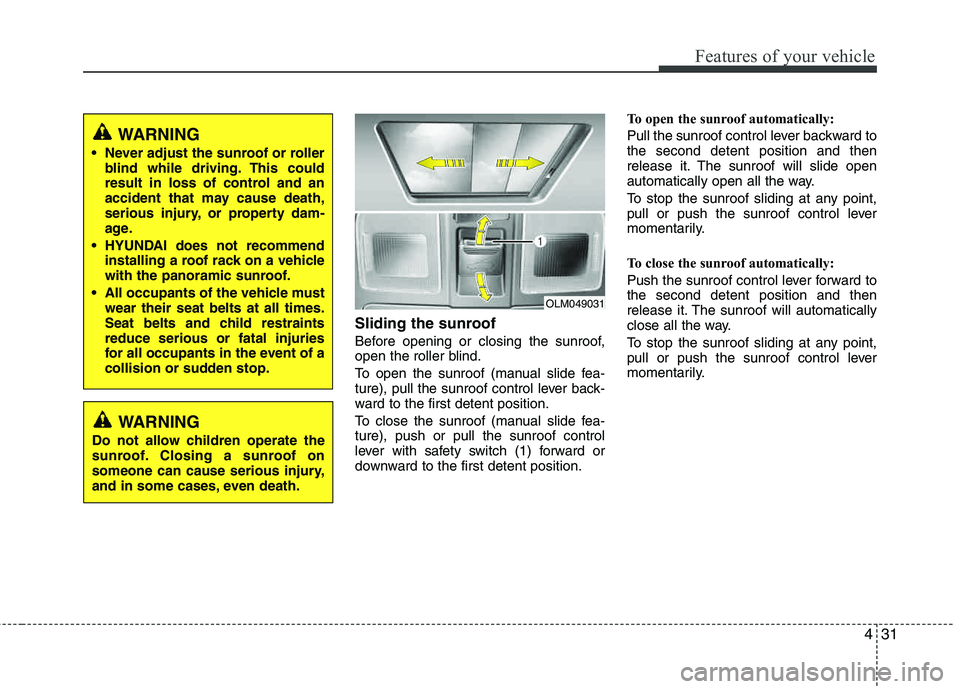
431
Features of your vehicle
Sliding the sunroof
Before opening or closing the sunroof,
open the roller blind.
To open the sunroof (manual slide fea-
ture), pull the sunroof control lever back-
ward to the first detent position.
To close the sunroof (manual slide fea- ture), push or pull the sunroof control
lever with safety switch (1) forward or
downward to the first detent position.To open the sunroof automatically:
Pull the sunroof control lever backward to the second detent position and then
release it. The sunroof will slide open
automatically open all the way.
To stop the sunroof sliding at any point,
pull or push the sunroof control lever
momentarily.
To close the sunroof automatically:
Push the sunroof control lever forward to the second detent position and then
release it. The sunroof will automatically
close all the way.
To stop the sunroof sliding at any point,
pull or push the sunroof control lever
momentarily.
OLM049031
WARNING
Never adjust the sunroof or roller blind while driving. This could
result in loss of control and an
accident that may cause death,
serious injury, or property dam-
age.
HYUNDAI does not recommend installing a roof rack on a vehicle
with the panoramic sunroof.
All occupants of the vehicle must wear their seat belts at all times.
Seat belts and child restraints reduce serious or fatal injuries
for all occupants in the event of a
collision or sudden stop.
WARNING
Do not allow children operate the
sunroof. Closing a sunroof on
someone can cause serious injury,
and in some cases, even death.
Page 176 of 397
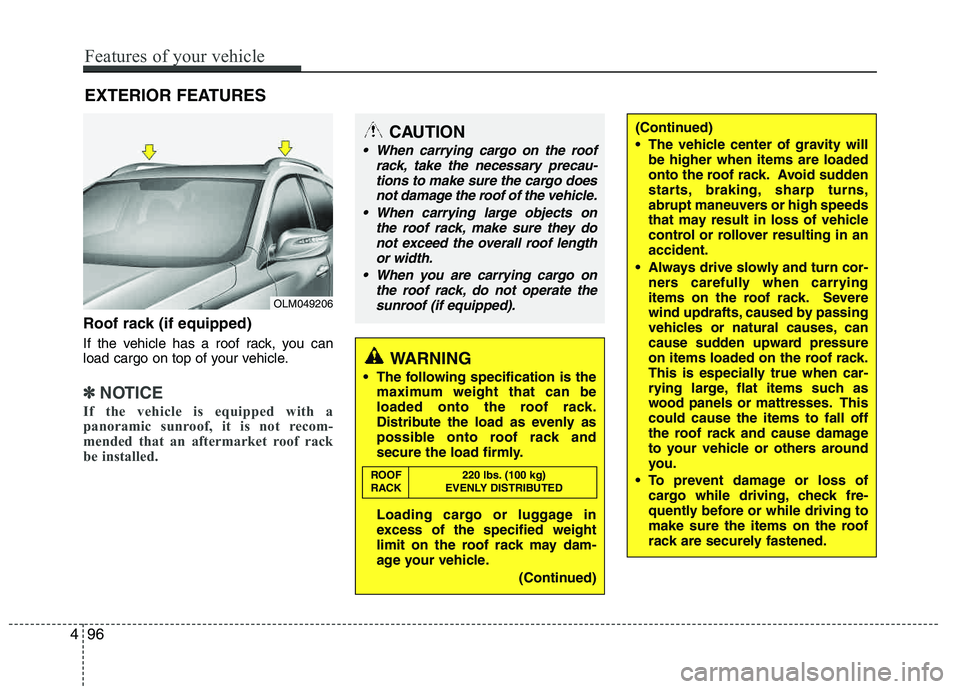
EXTERIOR FEATURES
496
Features of your vehicle
Roof rack (if equipped)
If the vehicle has a roof rack, you can
load cargo on top of your vehicle.
✽✽NOTICE
If the vehicle is equipped with a
panoramic sunroof, it is not recom-
mended that an aftermarket roof rack
be installed.
CAUTION
When carrying cargo on the roof rack, take the necessary precau-tions to make sure the cargo does
not damage the roof of the vehicle.
When carrying large objects on the roof rack, make sure they donot exceed the overall roof length
or width.
When you are carrying cargo on the roof rack, do not operate the
sunroof (if equipped).
OLM049206
WARNING
The following specification is the maximum weight that can be
loaded onto the roof rack.
Distribute the load as evenly as
possible onto roof rack and
secure the load firmly.
Loading cargo or luggage in
excess of the specified weight
limit on the roof rack may dam-
age your vehicle.
(Continued)
ROOF 220 lbs. (100 kg)
RACK EVENLY DISTRIBUTED
(Continued)
The vehicle center of gravity will
be higher when items are loaded
onto the roof rack. Avoid sudden
starts, braking, sharp turns,
abrupt maneuvers or high speeds
that may result in loss of vehicle
control or rollover resulting in anaccident.
Always drive slowly and turn cor- ners carefully when carrying
items on the roof rack. Severe
wind updrafts, caused by passing
vehicles or natural causes, can
cause sudden upward pressure
on items loaded on the roof rack.
This is especially true when car-
rying large, flat items such as
wood panels or mattresses. Thiscould cause the items to fall off
the roof rack and cause damage
to your vehicle or others around
you.
To prevent damage or loss of cargo while driving, check fre-
quently before or while driving to
make sure the items on the roof
rack are securely fastened.
Page 177 of 397
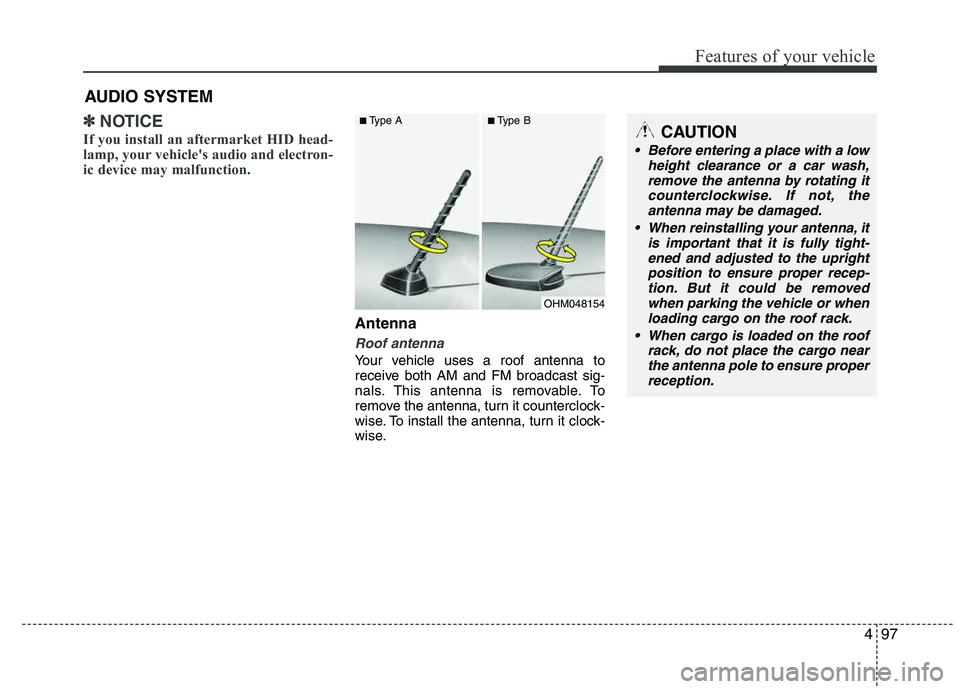
497
Features of your vehicle
✽✽NOTICE
If you install an aftermarket HID head-
lamp, your vehicle's audio and electron-
ic device may malfunction.
Antenna
Roof antenna
Your vehicle uses a roof antenna to
receive both AM and FM broadcast sig-
nals. This antenna is removable. To
remove the antenna, turn it counterclock-
wise. To install the antenna, turn it clock-
wise.
AUDIO SYSTEM
OHM048154
■
Type A ■Type B
CAUTION
• Before entering a place with a low
height clearance or a car wash,remove the antenna by rotating it
counterclockwise. If not, theantenna may be damaged.
When reinstalling your antenna, it is important that it is fully tight-
ened and adjusted to the uprightposition to ensure proper recep-tion. But it could be removed
when parking the vehicle or whenloading cargo on the roof rack.
When cargo is loaded on the roof rack, do not place the cargo near
the antenna pole to ensure properreception.
Page 235 of 397
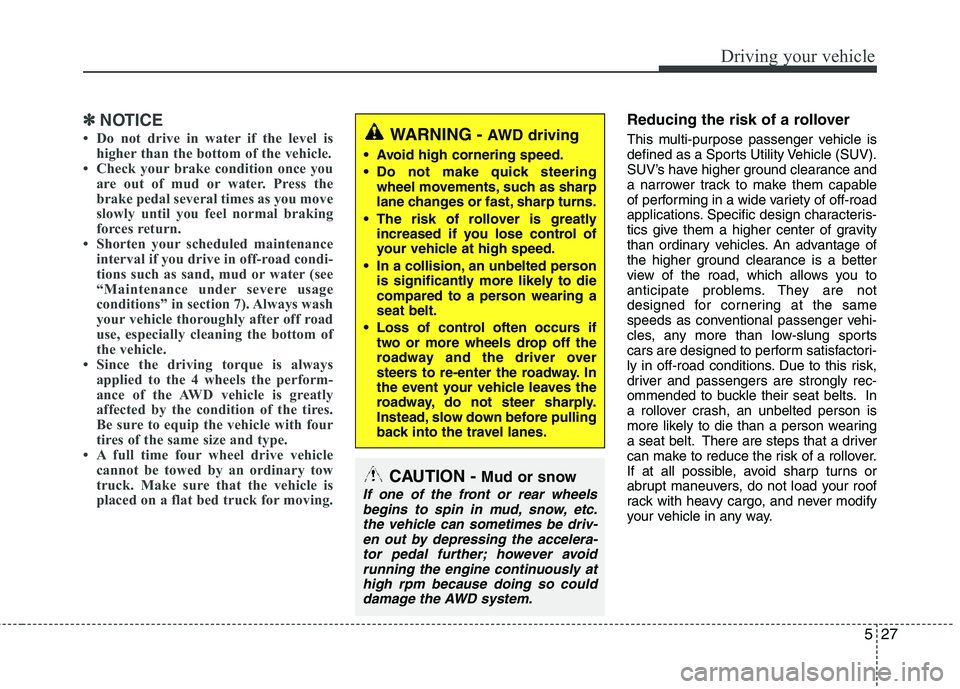
527
Driving your vehicle
✽✽NOTICE
Do not drive in water if the level is higher than the bottom of the vehicle.
Check your brake condition once you
are out of mud or water. Press the
brake pedal several times as you move
slowly until you feel normal braking
forces return.
Shorten your scheduled maintenance interval if you drive in off-road condi-
tions such as sand, mud or water (see
“Maintenance under severe usage
conditions” in section 7). Always wash
your vehicle thoroughly after off road
use, especially cleaning the bottom of
the vehicle.
Since the driving torque is always
applied to the 4 wheels the perform-
ance of the AWD vehicle is greatly
affected by the condition of the tires.
Be sure to equip the vehicle with four
tires of the same size and type.
A full time four wheel drive vehicle cannot be towed by an ordinary tow
truck. Make sure that the vehicle is
placed on a flat bed truck for moving.Reducing the risk of a rollover
This multi-purpose passenger vehicle is
defined as a Sports Utility Vehicle (SUV).
SUV’s have higher ground clearance and
a narrower track to make them capable
of performing in a wide variety of off-road
applications. Specific design characteris-
tics give them a higher center of gravity
than ordinary vehicles. An advantage of
the higher ground clearance is a better
view of the road, which allows you to
anticipate problems. They are not
designed for cornering at the same
speeds as conventional passenger vehi-
cles, any more than low-slung sports
cars are designed to perform satisfactori-
ly in off-road conditions. Due to this risk,
driver and passengers are strongly rec-
ommended to buckle their seat belts. In
a rollover crash, an unbelted person is
more likely to die than a person wearing
a seat belt. There are steps that a driver
can make to reduce the risk of a rollover.
If at all possible, avoid sharp turns or
abrupt maneuvers, do not load your roof
rack with heavy cargo, and never modify
your vehicle in any way.
CAUTION - Mud or snow
If one of the front or rear wheels
begins to spin in mud, snow, etc.the vehicle can sometimes be driv-
en out by depressing the accelera-tor pedal further; however avoid
running the engine continuously athigh rpm because doing so could
damage the AWD system.
WARNING - AWD driving
Avoid high cornering speed.
Do not make quick steering wheel movements, such as sharp
lane changes or fast, sharp turns.
The risk of rollover is greatly increased if you lose control of
your vehicle at high speed.
In a collision, an unbelted person is significantly more likely to die
compared to a person wearing a seat belt.
Loss of control often occurs if two or more wheels drop off the
roadway and the driver over
steers to re-enter the roadway. In
the event your vehicle leaves the
roadway, do not steer sharply.
Instead, slow down before pulling
back into the travel lanes.
Page 317 of 397
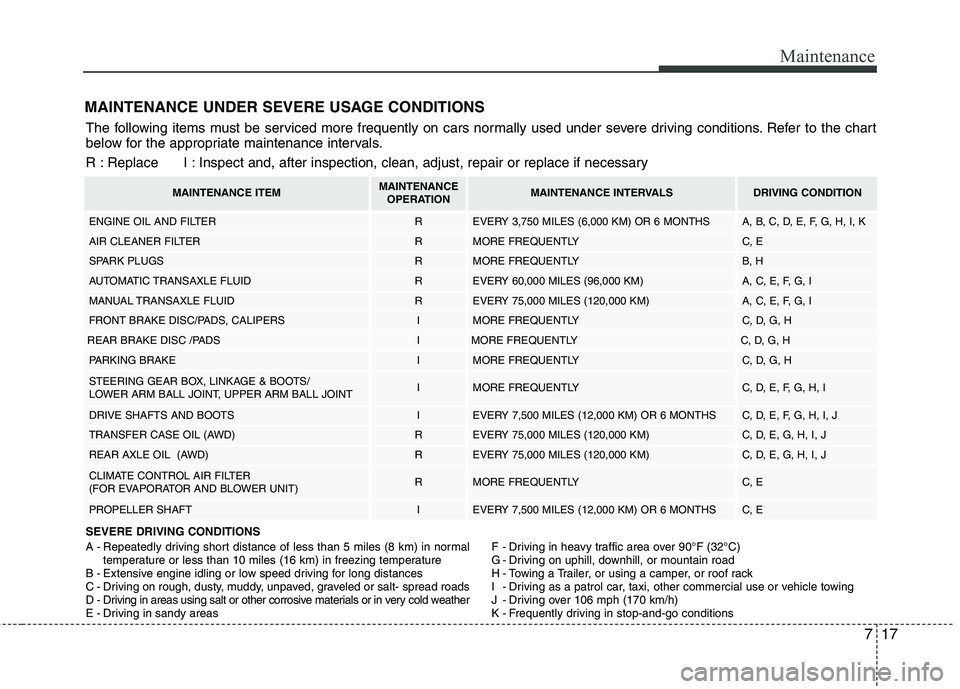
717
Maintenance
MAINTENANCE UNDER SEVERE USAGE CONDITIONS
SEVERE DRIVING CONDITIONS
A - Repeatedly driving short distance of less than 5 miles (8 km) in normaltemperature or less than 10 miles (16 km) in freezing temperature
B - Extensive engine idling or low speed driving for long distances
C - Driving on rough, dusty, muddy, unpaved, graveled or salt- spread roads
D - Driving in areas using salt or other corrosive materials or in very cold weather
E - Driving in sandy areas F - Driving in heavy traffic area over 90°F (32°C)
G - Driving on uphill, downhill, or mountain road
H - Towing a Trailer, or using a camper, or roof rack
I - Driving as a patrol car, taxi, other commercial use or vehicle towing
J - Driving over 106 mph (170 km/h)
K - Frequently driving in stop-and-go conditions
The following items must be serviced more frequently on cars normally used under severe driving conditions. Refer to the chart
below for the appropriate maintenance intervals.
R : Replace I : Inspect and, after inspection, clean, adjust, repair or replace if necessary
MAINTENANCE ITEMMAINTENANCE
OPERATIONMAINTENANCE INTERVALSDRIVING CONDITION
ENGINE OIL AND FILTERREVERY 3,750 MILES (6,000 KM) OR 6 MONTHSA, B, C, D, E, F, G, H, I, K
AIR CLEANER FILTERRMORE FREQUENTLYC, E
SPARK PLUGSRMORE FREQUENTLYB, H
AUTOMATIC TRANSAXLE FLUIDREVERY 60,000 MILES (96,000 KM) A, C, E, F, G, I
MANUAL TRANSAXLE FLUIDREVERY 75,000 MILES (120,000 KM) A, C, E, F, G, I
FRONT BRAKE DISC/PADS, CALIPERSIMORE FREQUENTLYC, D, G, H
REAR BRAKE DISC /PADSIMORE FREQUENTLYC, D, G, H
PARKING BRAKEIMORE FREQUENTLYC, D, G, H
STEERING GEAR BOX, LINKAGE & BOOTS/
LOWER ARM BALL JOINT, UPPER ARM BALL JOINTIMORE FREQUENTLYC, D, E, F, G, H, I
DRIVE SHAFTS AND BOOTSIEVERY 7,500 MILES (12,000 KM) OR 6 MONTHSC, D, E, F, G, H, I, J
TRANSFER CASE OIL (AWD) REVERY 75,000 MILES (120,000 KM)C, D, E, G, H, I, J
REAR AXLE OIL (AWD)REVERY 75,000 MILES (120,000 KM)C, D, E, G, H, I, J
CLIMATE CONTROL AIR FILTER
(FOR EVAPORATOR AND BLOWER UNIT)RMORE FREQUENTLYC, E
PROPELLER SHAFTIEVERY 7,500 MILES (12,000 KM) OR 6 MONTHSC, E
Page 377 of 397
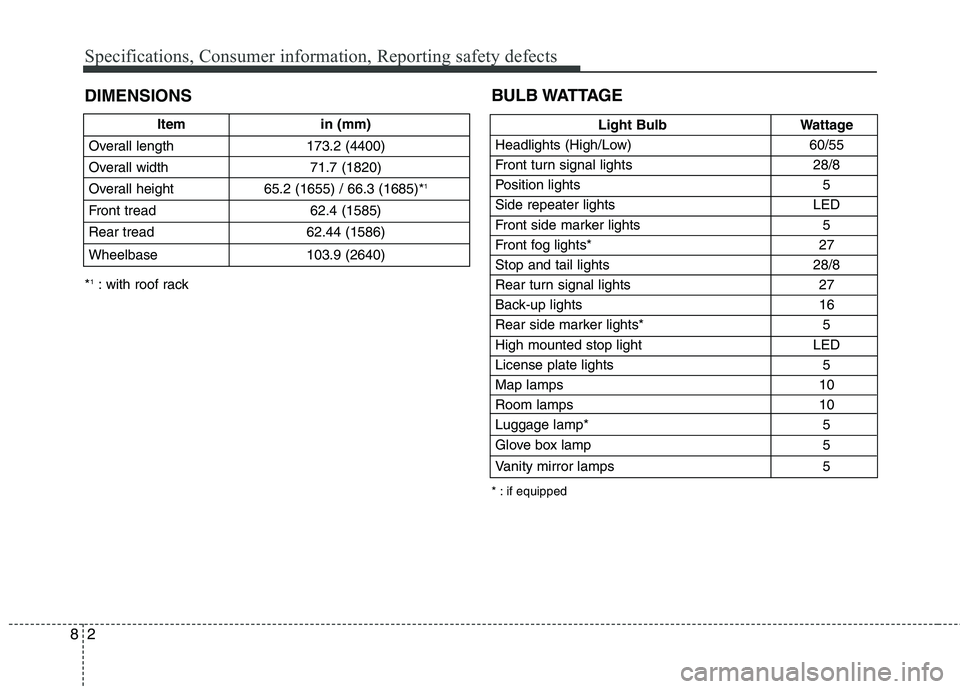
Specifications, Consumer information, Reporting safety defects
2
8
Item in (mm)
Overall length 173.2 (4400)
Overall width 71.7 (1820)
Overall height 65.2 (1655) / 66.3 (1685)* 1
Front tread 62.4 (1585)
Rear tread 62.44 (1586)
Wheelbase 103.9 (2640)
DIMENSIONS
Light Bulb Wattage
Headlights (High/Low) 60/55
Front turn signal lights 28/8
Position lights 5
Side repeater lights LED
Front side marker lights 5
Front fog lights* 27
Stop and tail lights 28/8
Rear turn signal lights 27
Back-up lights 16
Rear side marker lights* 5
High mounted stop light LED
License plate lights 5 Map lamps 10
Room lamps 10
Luggage lamp* 5
Glove box lamp 5
Vanity mirror lamps 5
BULB WATTAGE
* : if equipped
* 1
: with roof rack
Page 388 of 397
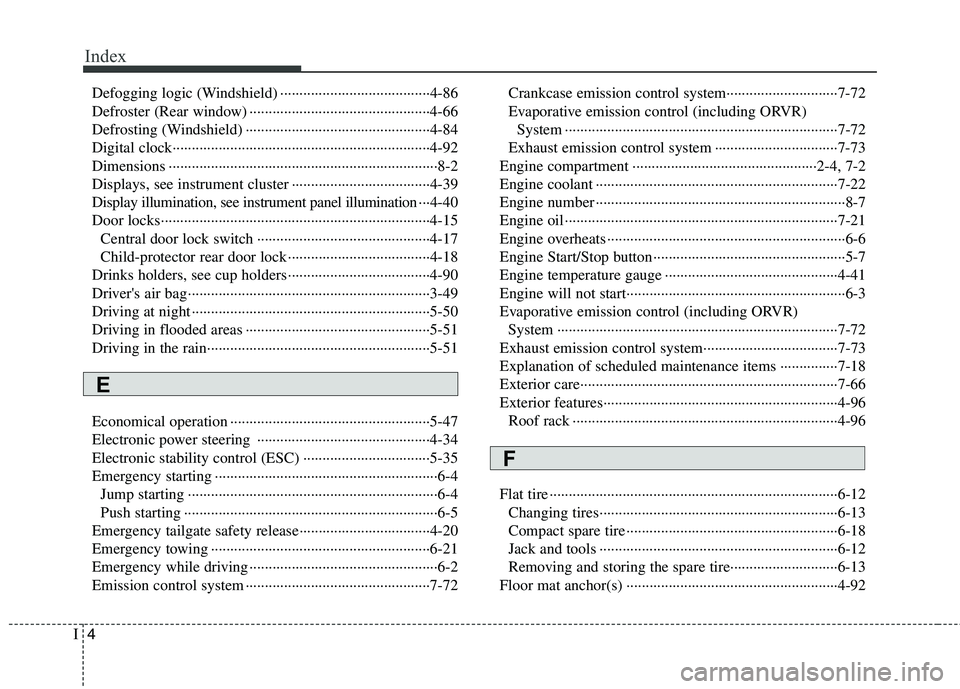
Index
4I
Defogging logic (Windshield) ·······································4-86
Defroster (Rear window) ···············································4-66
Defrosting (Windshield) ················································4-84
Digital clock···································································4-92
Dimensions ······································································8-2
Displays, see instrument cluster ····································4-39
Display illumination, see instrument panel illumination···4-40
Door locks······································································4-15 Central door lock switch ·············································4-17
Child-protector rear door lock ·····································4-18
Drinks holders, see cup holders·····································4-90
Driver's air bag·······························································3-49
Driving at night ······························································5-50
Driving in flooded areas ················································5-51
Driving in the rain··························································5-51
Economical operation ····················································5-47
Electronic power steering ·············································4-34
Electronic stability control (ESC) ·································5-35
Emergency starting ··························································6-4 Jump starting ·································································6-4
Push starting ··································································6-5
Emergency tailgate safety release··································4-20
Emergency towing ·························································6-21
Emergency while driving ·················································6-2
Emission control system ················································7-72 Crankcase emission control system·····························7-72
Evaporative emission control (including ORVR)
System ·······································································7-72
Exhaust emission control system ································7-73
Engine compartment ················································2-4, 7-2
Engine coolant ·······························································7-22
Engine number ·································································8-7
Engine oil ·······································································7-21
Engine overheats ······························································6-6
Engine Start/Stop button ··················································5-7
Engine temperature gauge ·············································4-41
Engine will not start·························································6-3
Evaporative emission control (including ORVR) System ·········································································7-72
Exhaust emission control system···································7-73
Explanation of scheduled maintenance items ···············7-18
Exterior care···································································7-66
Exterior features·····························································4-96 Roof rack ·····································································4-96
Flat tire ···········································································6-12 Changing tires······························································6-13
Compact spare tire ·······················································6-18
Jack and tools ······························································6-12
Removing and storing the spare tire····························6-13
Floor mat anchor(s) ·······················································4-92
E
F
Page 391 of 397

I7
Index
Luggage net (holder) ·····················································4-93
Luggage rack, see roof rack···········································4-96
Lumbar support································································3-7
Main fuse and multi fuse ···············································7-53 Maintenance Explanation of scheduled maintenance items ·············7-18Maintenance services·····················································7-3
Maintenance under severe usage conditions ···············7-17
Normal maintenance schedule·······································7-7
Owner maintenance ·······················································7-4
Scheduled maintenance service ·····································7-6
Tire maintenance ·························································7-42
Maintenance services ·······················································7-3
Manual climate control system······································4-68 Air conditioning ··························································4-73
Climate control air filter ··············································4-75
Heating and air conditioning ·······································4-69
Manual heating and air conditioning ·····························4-79
Manual transaxle····························································5-13
Memory fuse ··································································7-52
Mirrors ···········································································4-36 Inside rearview mirror ·················································4-36
Outside rearview mirror ··············································4-37
Moonroof, see sunroof···················································4-30 Neck restraints, see headrest ··································3-8, 3-12
Occupant classification system ······································3-44
Odometer/Tripmeter ······················································4-43
Oil (Engine) ···································································7-21
Outside rearview mirror·················································4-37
Overheats ·········································································6-6
Owner maintenance ·························································7-4
Panoramic sunroof ·························································4-30
Parking brake························································5-31, 7-27
Passenger's front air bag ················································3-49
Position light bulb replacement ·····································7-61
Power brakes ··································································5-30
Power outlet ···································································4-91
Power window lock button ············································4-24
Pre-tensioner seat belt····················································3-24
Push starting·····································································6-5N
P
MO
Page 392 of 397
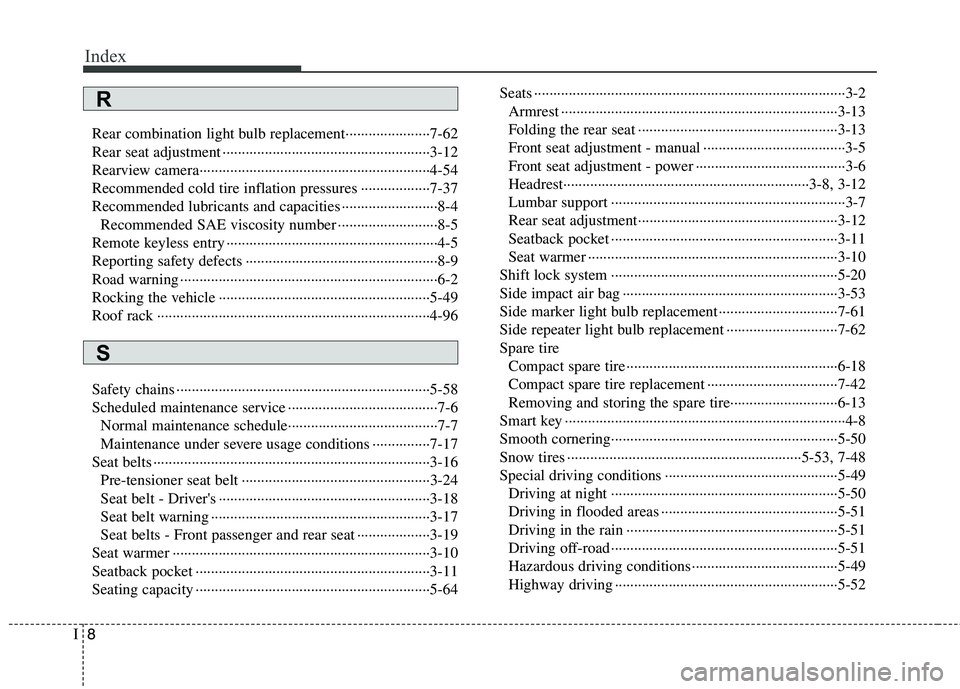
Index
8I
Rear combination light bulb replacement······················7-62
Rear seat adjustment ······················································3-12
Rearview camera····························································4-54
Recommended cold tire inflation pressures ··················7-37
Recommended lubricants and capacities ·························8-4Recommended SAE viscosity number ··························8-5
Remote keyless entry ·······················································4-5
Reporting safety defects ··················································8-9
Road warning ···································································6-2
Rocking the vehicle ·······················································5-49
Roof rack ·······································································4-96
Safety chains ··································································5-58
Scheduled maintenance service ·······································7-6
Normal maintenance schedule·······································7-7
Maintenance under severe usage conditions ···············7-17
Seat belts ········································································3-16 Pre-tensioner seat belt ·················································3-24
Seat belt - Driver's ·······················································3-18
Seat belt warning ·························································3-17
Seat belts - Front passenger and rear seat ···················3-19
Seat warmer ···································································3-10
Seatback pocket ·····························································3-11
Seating capacity ·····························································5-64 Seats ·················································································3-2
Armrest ········································································3-13
Folding the rear seat ····················································3-13
Front seat adjustment - manual ·····································3-5
Front seat adjustment - power ·······································3-6
Headrest································································3-8, 3-12
Lumbar support ·····························································3-7
Rear seat adjustment····················································3-12
Seatback pocket ···························································3-11
Seat warmer ·································································3-10
Shift lock system ···························································5-20
Side impact air bag ························································3-53
Side marker light bulb replacement ·······························7-61
Side repeater light bulb replacement ·····························7-62Spare tire Compact spare tire ·······················································6-18
Compact spare tire replacement ··································7-42
Removing and storing the spare tire····························6-13
Smart key ·········································································4-8
Smooth cornering···························································5-50
Snow tires ·····························································5-53, 7-48
Special driving conditions ·············································5-49 Driving at night ···························································5-50
Driving in flooded areas ··············································5-51
Driving in the rain ·······················································5-51
Driving off-road ···························································5-51
Hazardous driving conditions ······································5-49
Highway driving ··························································5-52
S
R